A | B | C | D | E | F | G | H | I | J | K | L | M | N | O | P | Q | R | S | T | U | V | W | X | Y | Z
- Alcmene
- In Greek mythology, Alcmene was the mother of Heracles who, after she died, was worshipped as a Goddess in Thebes and Athens. The story goes that after she died, Zeus got Heracles to steal her body and put a stone in her coffin in her place. Then Zeus brought her to the Isles of the Blessed where she was revived and married Rhadamanthys (he was cool, trust me).n

- Anaitis
- Anaitis was an Asiatic goddess who represented the creative powers of nature. She had slaves from famous families - the women she made temple prostitutes, the men she made were made protectors of the land surrounding the temple. The Greeks associated her with both Aphrodite (obviously) and Artemis (not so obviously).
- Ananke
- Ananke was the divine personification of Fate and Necessity. Her nature was extremely unalterable so she didn't have very many temples. I guess people figured that they wouldn't change her mind. She was also the mother of the Fates and Adrastea (though some people say that their mother was Themis).
- The Parnassides
- Another name for The Muses because of their birth on Mt. Parnassus.
- Pepromene
- Pepromene was the personification of the idea that every human is tied to a destiny. This is basically the same as Ananke (Fate).
- Perse
- Perse was one of the underworld moon Goddesses. She was the consort of Helios and bore Circe, Aeetes, Perses, Aloeus, and Pasiphae (and all her kids had some serious magical talent). She was also called Naeara or the New One, the embodiment of the New Moon. An interesting point here is that all her kids were called 'Perseides' rather than Heliades (like the rest of Helios' kids). Unclear whether or not that was because her influence was more important in terms of who these kids would become, because she was super cool all on her own, or if Heliades just applies to later kids.
- Prosymna
- Prosymna was one of the names for the New Moon. She was also a nurse of Hera with her sisters: Acraea and Euboea.
- Rumor
- See Ossa, above. She was a swift-footed and feathered demon goddess who delivered messages - not always truthfully.n
- Semnai
- Semnai is another name for the Erinyes. It means the 'Venerable Ones,' it is a euphemism like the Eumenides.
- Styx
- Wrong page, sweetheart. Try here.n
- Aceso
- Aceso was a goddess personifying the healing process. She was the daughter of Epione and Asclepius (the main healer dude) and sister to Aegle, Hygeia, Panaceia, and Iaso. Like the other members of her family, she was a Goddess of Healing. She shared an altar with her sisters and Aphrodite and Athena at Epidauros.
- Achelois
- Achelois means 'she who drives away pain'. She was a Moon Goddess, which wasn't really that uncommon. The Dodonian Oracle ordered sacrifice to her. But according to Tzetzes (this old Roman dude), Achelois was one of the seven Muses said to be the daughters of Pierus.
- Achlys
- She was the personification of Eternal Night, what was believed to have presaged Chaos. There was another who personified Misery, and Hesiod described her in the Shield of Heracles: 'And beside them [the Keres and the Moirai] was standing Akhlys, dismal and dejected, green and pale, dirty-dry, fallen in on herself with hunger, knee-swollen, and the nails were grown long on her hands, and from her nostrils the drip kept running, and off her cheeks the blood dribbled to the ground, and she stood there, grinning forever, and the dust that had gathered and lay in heaps on her shoulders was muddy with tears.' How pleasant.n

- Adicia
- Adicia was the female personification of injustice. According to Pausanias there was this picture of the beautiful Dike dragging the ugly Adikia and beating her with a staff.
- Adrastea
- The name means something like, 'unyielding,' and is a surname of Nemesis. Another chica named Adrastea was the daughter of Amaltheia (a nymph) and King Melisseus of Crete, and she took care of the infant Zeus with her sister, Ida, and the Curetes (these guys - whom some say were her brothers - who danced around and beat their weapons really loudly so that Cronos wouldn't hear Zeus' cries). Adrastea was a good babysitter and kept baby Zeus occupied with a pretty globe. n
- Aedos
- She was the personification of Modesty or Shame. She is often mentioned alongside Nemesis, who was goddess pretty big on conscience. Penelope's dad, Icarius, built a statue of Aedos about 6 miles outside of Sparta after his darling daughter left him for Odysseus.
- Aega
- Aega was a lot of people. I will mention the more important ones. In one version she and her sisters suckled the infant Zeus and she was put in the sky later as the constellation Capella. In another version, she was chosen to suckle Zeus but couldn't cut it, so Amalthea came in to take her place. In another version she was a daughter of Helios who was so bright that when the Titans were attacking Olympus they had to ask Gaia to hide her - then she was stuck in a cave, where she ended up suckling Zeus. Zeus got the aegis from the goat version of Aega. Aega is mostly translated as 'goat,' but can also be said to be 'gale of wind.'
- Aegle
- One of the daughters of Aesclepius and Lampetia, or, more commonly, Epione. Like her sisters she was a Goddess of Healing. But she, like Iaso, is very rarely considered to be above demi-goddess level. Human Aegle was a couple of different people. There was also a nymph Aegle. Her name means 'Brightness' or 'Splendor' and she personified the 'glowing health of the human body.'n

- Aergia
- Aergia is the personification of laziness. Her parents, as if these details really matter, were Gaia and Aither (the Upper Air).
- Aesa
- Aesa was a (not the) personification of destiny. She is described sometimes as one of the Fates, but others say that she is from Argive only, and others say that she should be viewed in tandem with Ate. She had a sword. Yes.
- Aetae
- See the Litae.
- Aetna
- Aetna was the daughter of Gaia and Uranus. She was the personification of Mt. Etna, you know, the one Zeus threw on Typhon? What? You don't? Well, then you should keep looking for the new myths page filled with creation stories! Anyway, back to Aetna. She was a volcano (thanks to the fire-breathing Typhon, who lives underneath her). When Demeter and Hephaestus were arguing over Sicily (land of volcanoes and corn) Aetna stepped in to arbitrate. She is regarded in Sicilian myth as the mother of the Palici (twin Sicilian gods of geysers, no not fogies, like water geysers).n

- Agdistis
- Agdistis was a totally awesome figure in mythology, and I'll probably move her to the goddess section soon, because she's really not so monstrous. It all started when Zeus had a wet dream and came on Gaia - that is, the ground. Gaia, fecund as we all know, got pregnant, and Agdistis soon emerged. She was born a hermaphrodite, but her bi-sexed body totally intimidated the gods, who feared that her body made her so powerful that she'd take over the world. So they cut off her penis. They buried it in the ground and it grew into an almond tree (think about THAT the next time you eat a handful of almonds) and the daughter of the Sangarius river came along and, according to Pausanias, put one of the almonds between her breasts (whatever floats your boat ...). Although this may seem a little unorthodox, the almond disappeared and - surprise surprise - Nana (the nymph) found out that she was pregnant. She had a child named Attis - who grew up to be a major hottie, and then Agdistis fell in love with him. Agdistis, apparently, was still pretty intimidating, and Attis' relatives weren't down with her, so they sent him off to marry a princess, but Agdistis showed up at the wedding in true romantic style. The only thing is, when she stood up to say, 'Wait! You can't marry that girl, I love you!' (or whatever), instead of everything working out happily ever after, Attis went completely nuts. He ran into the wilderness and castrated himself and, as this story goes, bled to death. His spirit entered a pine tree, but Agdistis was less worried about the soul, and more worried about the body, and she asked Zeus if he could preserve the body eternally for her. It's a little kinky, if you ask me, but as we all know, Zeus is down with kink, so he agreed and they put the body in a tomb in the sanctuary of Cybele (Rhea). Eventually, Agdistis became an epithet of Cybele's. There were ceremonies replaying the whole Attis myth every year, and I hope to get the whole Attis myth in the Myth Pages one of these days. n

- Aglaia
- I'm not sure I should put her up here in her own entry. Aglaia was, as you can probably figure out from the entry above, the personification of bright splendorous magnificence. She was the wife of Hephaistos and the mother of some Graces, but the reason I don't think she should get her own entry is because she WAS one of the three Graces (Charites). The reason she ultimately got her own entry is because despite her inclusion in that number, she was also sometimes referred to as The Grace, the one who embodied all three. Also, an important note, apparently she had large breasts.n

- Alala
- The female personification of the war-cry.
- Alcyone
- Alcyone, also said 'Halcyone,' is the Goddess of the Sea, the Moon, Calm, and Tranquility. There was also a Pleiade named Alcyone (check out the Nymphs page for that). She was the daughter of Aeolus and wife of Ceyx. She and Ceyx were a very happy couple, but then Ceyx died in a shipwreck and Alcyone threw herself into the sea (what can you do? She was a silly young girl then). The gods took pity and turned the two into birds (Alcyone became a halcyon, or a kingfisher, and Ceyx became a ceyx, or a gannet). Alcyone made her nest on the beach, and waves were big and scary, but the gods made the sea calm so she could lay her eggs. Therefore, 'halcyon days,' when storms never occur. Ahhhhhhh. It is she who brings life to death and death to life.
- Alectrona
- Alectrona was an early Goddess of the Sun, who became a daughter of Helios once classical myth, ie, patriarchal myth, came along.
- Alethia
- Alethia was the Goddess of Truth. She was born of Zeus and Apollo's nurse.
- Algea
- She was the personification of Sorrow and Grief. She was the daughter of Eris.
- Alphito
- Alphito was the Arcadian White Grain Goddess as a Sow. But by Classical timesshe was barely remembered. She was given sole rights over the ability to inflict leprosy. Scary. But she was kind of scary, so . . . Again, I have lost my source, so I can't verify this at all. What I CAN say for sure is that 'alphito' is the Greek word for 'barley.'n
- Amphictyonis
- Amphictyonis, now there's a mouthful, she was the Goddess of Wine, and of Friendship Between Nations. I could see how she could come in handy, but I don't see how anyone drunk on the Wine that she's the Goddess of could say a toast in her name! Actually, Amphictyonis was just a surname of Demeter, to whom sacrifices were offered at the beginning of every meeting (in Thermopylae).n
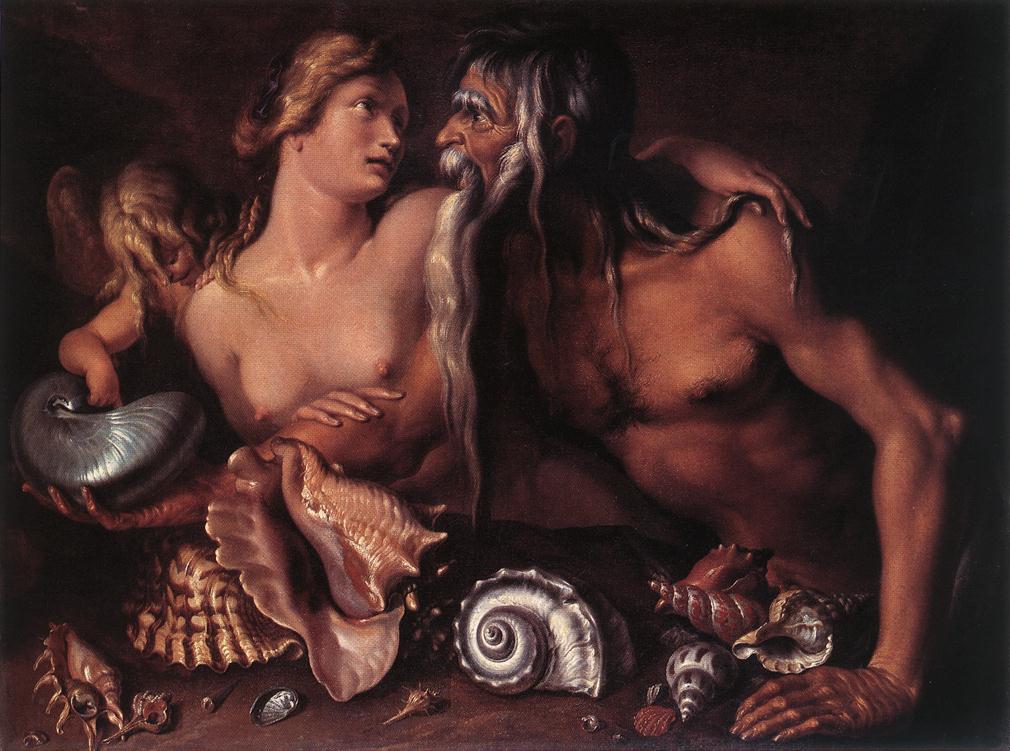
- Amphitrite
- Amphitrite was a Nereid (or possibly an Oceanid, depending on who like better) and she married Poseidon. She was the Goddess of the Mediterranean Sea. Her symbol is the dolphin. The stories say that she was not a jealous wife, and didn't care if her husband slept with anyone else (except for Scylla, who she poisoned and turned into a sea-monster, unless of course that was Circe). Her children were Triton, Benthesicyme, and Rhode. Her name means, 'the third one who encircles,' how mysterious. She and her sister, Thetis, shared the surname Halosydne, which means 'sea-born.' Okay, this description blows. She sounds totally boring, and the thing is that I don't think she was. In fact, I find her a lot closer to how a 'normal woman' would be than in fact many of the human women listed here. She didn't immediately go for her husband, but fell for him after he tried really hard. She generally put up with his shenanigans, but got pissed every once in a while (like when she turned Scylla into a monster). She had a job, she did it, but didn't get that much worship for it (Poseidon tended to get that), however people did like recognizing her for her beauty and image. A virtual paradigm of womanhood in a patriarchal world this goddess! You could even claim to see the self-perpetuating cycle of women in patriarchal power in her demand for a sacrifice of virgin girls from the first settlers of Lesbos. Heh.
- Anchiale
- Anchiale was a Titaness and the mother of the Dactyls (Five brothers who were masters of metallurgy and sorcery). Since the Dactyls are also considered the children of Rhea, perhaps Anchiale is just another name for that Goddess.
- Antheia
- Antheia was the Goddess of Vegetation, Lowlands, Marshlands, Gardens, Blossoms, the Budding Earth, and Human Love.
- Apate
- Apate was the Goddess of Deceit, she was one of the Spirits in Pandora's box. Her parents were Nyx and Erebus.
 Aphrodite
Aphrodite- Aphrodite was the Goddess of Love and Beauty. She's definitely important enough to have her own page. According to The Odyssey she was the daughter of Zeus and Dione, other myths speak of her as springing from the blood of Uranus after Cronus castrated him, and floating on the sea to Greece, where she was met by the Three Graces (who will be discussed later). The latter is the more accepted version. Personally I dislike her because she is exceedingly vain and thinks only of herself. I like to laugh at her eternal beauty and loveliness because she was a great grandmother of another God, Dionysus (who she also had a child by). She was married to Hephaestus, the Smith God, but she lusted after Ares, the much disliked God of War. She was also the patron Goddess of Prostitutes. Read more about Aphrodite.
- Arae
- The personifications of curses. They were invoked during the spells of witches.
- Arce
- The sister of Iris. Before the Olympian Gods took over, she was the Messenger Goddess for the Titans. When Zeus took the throne, he cast Arce into Tartarus.
- Arete
- Arete was Heracles' teacher and a Goddess of Justice.
 Artemis
Artemis- She's definitely my favorite goddess, and so, of course, has her own page. Artemis was the Goddess of the Hunt. She had 50 hounds and 50 Dreiads (wood nymphs) and a quiver full of painless silver arrows. She was the daughter of Zeus and Leto as well as being last of the Three Maiden Goddesses. She was also a part of the Triple Goddess. The Triple Goddess was the Moon in three forms. Artemis didn't carry the moon across the sky, yet she was still known as the moon. Although she was stunningly beautiful, she was very cold and she swore never to marry. She had only one love, a hunter named Orion (and even that's debatable). She was the Protector of Young Women. She was incredibly cool (coming from a young woman). The picture is copyrighted by Hrana Janto, who is the painter - with whose kind permission I am using the painting. You can check out some of her other Goddess (and other) paintings on her site. Read more about Artemis.
- Astarte
- Astarte was the Fertility Goddess, she was helpful whether one wanted to bear a child or plant a garden.
- Asteria
- Asteria was a daughter of Phoebe, a sister of Leto. She hurled herself into the Sea after being abducted by Zeus. She became the island of the same name.
 Astraea
Astraea- Astraea was a Goddess of Justice, Innocence, and Purity. It is generally accepted that she was the daughter of Themis and of Zeus. She was the last immortal to withdraw from the Earth after the Golden Age. It was she that held aloft the scales weighing the opposing parties claims. When she joined the rest of the Gods in the stars, she became the constellation Virgo.n
- Ate
- She was the Goddess of Evil and Misfortune and also the personification of Infatuation - 'the rash foolishness of blind impulse, usually caused by guilt and leading to retribution. She was, (surprise surprise) the daughter of Eris (see below) and Zeus. She was a temptress, and lead humans toward evil. She actually trapped Zeus once, but he would have none of that, and threw her (literally) off Olympus. She has sisters, the Litai (or Prayers), who follow her around and clean up her messes.
 Athena
Athena- I could talk about Athena forever, but I'll attempt to be brief. She's definitely important enough to have her own page. Athena was the Patron Goddess of Athens, the Goddess of Wisdom, and the Goddess of Weaving. She was the Goddess of lots of other things, too, but I'm being brief. She was also a warrior and another of the Three Virgin Goddesses. Her father was Zeus. Technically her mother was Metis (Goddess of Prudence), but it is generally accepted that she had no mother. Athena was Greece's favorite Goddess, and there are many stories about her. Read more about Athena.
- Auxesia
- Auxesia was a Goddess of Growth.
- Bia
- I had Bia in here before, but then I thought she was a guy. Now I know she is a girl and she's back. She's the personification of Force and Power, the daughter of Pallas and Styx. Pallas, in this case, being a boy and a Titan, not Athena or a nymph (or even a Giant for that matter). Anyway, she's the sister of Nike, Cratos (Power) and Zelus (Rivalry). She bound Prometheus as punishment for his stealing fire from the Gods for us insignificant humans.
- Bolbe
- A Lake Goddess.
- Brimo
- The Angry One, she was associated with the dark earthy life-and-death goddesses like Hecate, Persephone, Demeter and even Cybele. And by 'associated' I mean that her name was sometimes used to modify the other goddesses' names, like 'Persephone the Angry One.' A goddess in her own right in a couple of places where other chthonic deities were worshiped, but more commonly known in conjunction with the big name ladies.n

- Britomartis
- The Angry One, she was associated with the dark earthy life-and-death goddesses like Hecate, Persephone, Demeter and even Cybele. And by 'associated' I mean that her name was sometimes used to modify the other goddesses' names, like 'Persephone the Angry One.' A goddess in her own right in a couple of places where other chthonic deities were worshiped, but more commonly known in conjunction with the big name ladies.n

- Brizo
- She was worshipped by the women of Delos (not the men, for some odd reason) as the Protector of Mariners. Food offerings were set out for her in little boats (no fish, of course). Brizo was (or gave answers to) an oracle who gave answers in dreams about navigation and fishing matters. Very interesting. Hmmm. That's one I didn't know about before Encyclopedia Mythica.Another quick note: the 'kappa' of ancient greek makes a hard 'k' sound, but was often Latinized to a 'c' which is how I spell it a lot. But not all the time. If they're not here, check below and vice versa.
- Caligo
- Called the mother of Chaos. With Chaos, she gave birth to Nyx.
- Callipygos
- This is sometimes a surname for Aphrodite. It means 'beautiful buttocks'.
- Calypso

- There's more on her in the nymph section, but now she's here to, as she should be. Daughter of the Titan Atlas, she lived on the island Ogygia. This was where Mr. Odysseus (of the Odyssey, yes, that's one you should know) was washed ashore. Calypso fell in love with this shipwrecked hunk o' burnin' love, and offered him eternal life to stay with her (which he refused, good for him - he had a wife, Penelope). They were lovers, though against his will. After seven years, Athena complained for Odysseus to Zeus, and Hermes was sent to Calypso to order her to set him free. She did so reluctantly, helping him make a small boat to get free of the island. Oooh, and her name means Hidden or Hider. Very appropriate, no?
- Carya
- Carya was a pre-classical mythology goddess. She was the Goddess of the Walnut Tree. That is a Cool Ass job. Wow. Later she was added to the Artemis myth, as Caryatis.
- Castalia
- A fountain Goddess. She had a fountain on Mt. Parnassus that was the sacred place of the Muses.
- Celaeno
- Now this is a chica with a lot of choices. Her name means the Dark and she was also known as Podarge (Fleetfoot) as one of the Harpies. Celaeno the Harpy was the mama of Xanthus and Balius, the magic horses of Achilles (by Zephyrus, her lover). Of course, another version of Celaeno says she is a Pleiade, and the lover of Poseidon, mother of Lycus by him (and Deucalion by Prometheus, besides). This is one busy lady.
- Cer
- The personification of Violent Death. She was a daughter of Nyx.
- Ceto
- Ceto was one of the original Titans. She was one of the few who had a true mate: Phorcys. In addition to being her husband, Phorcys was her brother. As were Thaumas and Eurybia. Ceto and Phorcys were the parents of the Gorgons. Ceto was the personification of all the Horrors of the Sea.n

- The Charites
- The Charites (or the Graces) were three happy Goddesses of Beauty. They were named:
- Aglaia, Splendor
- Euphrosyne, Mirth
- Thalia, Good Cheer
- Chloe
- An epithet for Demeter. It means Green. Makes sense for an agricultural deity!
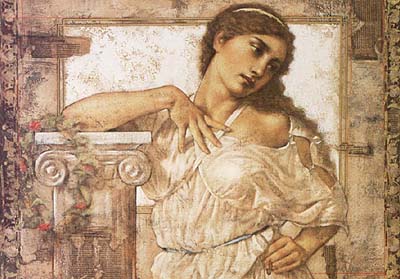 Chloris
Chloris- Chloris was the Goddess of Flowers. She is the spouse of Zephyrus, the West Wind. He abducted her and gave her dominion over flowers. That picture right next to this, that's Chloris (not Flora). This was also the name of the only child of Niobe spared by Apollo and Artemis. To the Romans she was known as Flora, sound familiar? To be honest, she seems like much more of a Roman type of deity (email me for the fascinating differences between them) than Greek, but I thought I'd give Ovid the benefit of the doubt.n

- Circe
- Circe was the daughter of Hecate (or Perse) and Helios (the Sun-God). She was a union of opposites. Just look at her parents: one is the Dark Moon and the other is the Sun. The sorcery bit goes hand in hand with the celestial powers, so that's alright, but just mentioning that she was witchy does not begin to encompass her. Her biggest part is played in the Odyssey (you don't remember? I'm so ashamed ...), and she had her own island (near her dad's, actually) off the coast of Italy where she liked to catch sailors and other random men and turn them into things (like pigs). Apparently, she was also pretty good in the sack, because Odysseus delayed his 'urgent' return to Penelope at least a year and contributed his sperm towards at least two kids (Telegonus and Cassiphone). Although she wasn't thrilled to see him go (like her predecessor Calypso she gave him super good advice that he actually followed (always listen to witches!). There's some funky endings to that relationship including that Penelope brought Odysseus' body to be buried on Circe's island after he died (what?) and that Odysseus' son killed Circe and then that Cassiphone killed him. Another story that made it to the myth pages about Circe and Scylla (and Glaucus) can be found here. n

- Cotys
- Also known as Cotytto, she was a Thracian goddess (yes, that still counts as Greek) but she seems almost like a Bacchante because her rituals are so similar to those of Rhea and Dionysus. Basically, it involved lots of noise (cymbals, drums, what have you) and lots of other orgiastic ritual stuff they may or may not have involved sex. That painting's one of Sandra Stanton's images of Cybele, but it seemed appropriate.n
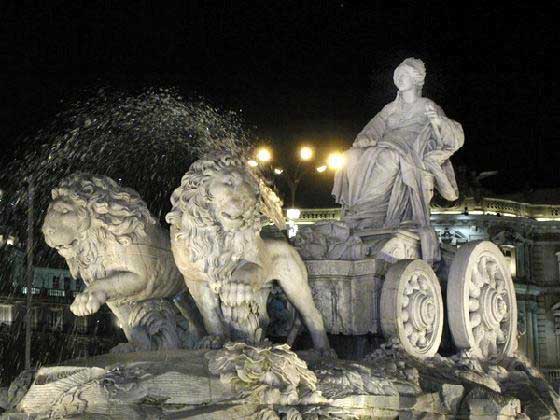
- Cybele
- Cybele wasn't technically a Greek goddess in that she came from Phrygia, but she was worshipped in Greece and Rome and a whole rack of other places, too so I think she should be here. It is interesting (at least to me) that she was never appropriated as completely Greek, but always seen as exotic (kinda like Dionysus that way). Well, maybe that's not completely fair since she was super strongly identified with Rhea. Anyway, she, like a bunch of the big names, isn't just a personification. She's all up in fertility and nature and had some crazy mysteries like Demeter, but Demeter isn't known for orgies, sadomasochism, or gender queer priests like Cybele is. Interested? Check out her most important myth in the Myth Pages. You can see her in a very typical representation in the photo at right.
- Cynthia
- The epithet of Artemis, because of her birth on Mt. Cynthus on Delos. For the same reason Apollo is called Cyntheus.
- Cytherea
- This is an epithet of Aphrodite, referring to her birth rising from the sea near the island of Cythera, where she was worshipped mucho mucho more.n
- Damia
- Possible epithet of Demeter. She was a Goddess of Growth in Nature. I don't know very much about her though.
- *Demeter*
- Demeter was another daughter of Rhea and Cronus and one of the 12 recognized Olympian Gods. She was the Goddess of the Harvest or the Goddess of the Fields and she's definitely important enough to have her own page. In her own time she was revered as much as Zeus was himself because her temper determined the lives of those on Earth. Centuries ago Greeks used to break bread in the name of Demeter as well as drink wine to Dionysus. Sound familiar? Demeter was also the mother of Persephone (see below). The Eleusinian Mysteries were dedicated to the worship of both she and her daughter and I highly recommend that you Read More About Demeter.
- Dendritus
- Her name means 'Tree Youth' and she was a Goddess of Trees.
- Derceto
- A fertility goddess.
- Despina
- Despina was (supposedly) the daughter of Poseidon and Demeter. Her name means Mistress. 'Despina' is also an epithet for multiple goddesses, like Demeter, Aphrodite, and Persephone.
- Dike
- I love this Goddess. I think she is too cool (except that Nemesis is cooler, but that's okay). Yes. Anyway, Dike was probably the daughter of Zeus and Themis (although parentage is always debatable). She may have started her career on Earth, but quickly moved up to sitting on the Right (Dike means Right) of Zeus as his number one counselor (sitting right across from her mom, Themis). She was the Goddess of Justice. (Don't you just love how many Justice and Vengeance Goddesses there were?) She was 'the best of all the virgins' on Olympus, and I assume that includes Artemis and Athena, so that's saying something. Dike is also one of the Horae. We've had a bit of debate on this point. She actually had a daughter, Hesychia, who was the personification of tranquility, and an attendant of her very own: Poene. If you did good, she helped you out but punished those who were bad, for example, the goddess Adikia who she can be seen dragging around and beating with a staff or hammer.
- Dione
- Okay, I went a-researchin' in my friend's book of Greek Myths. It says that Dione was the daughter of Epimetheus, who was the son of the Titan Japet. She was one possibility as the mother of Aphrodite. She was believed by some to be an ancient Earth Goddess, or the Goddess of the Oak. In other cases it is said that she is the female version of Zeus. (I tend to hang more with the latter explanation.)
- Doris
- Doris was best known for being the mother of all of the Nereids. She was the daughter of Tethys and Oceanus, both Titans.
- Dysnomia
- The personification of Lawlessness. She was a daughter of Eris.n
- Ececheira
- She was really cool. She was the personification of Armistice and Truce. She was at all the Olympics to keep the peace.
- Efreisone
- According to P J Criss, it is 'the female personification of a Greek ritual object: a branch of olive wood, twined with wool and hung with fruits, which was carried in festivals by children with two living parents.'
- Eileithyia
- Eileithyia was the Goddess of Childbirth She is most known from the birth story of Artemis and Apollo, for it was she who went to Leto on the tiny island of Delos. She was a scion of Hera's.
- Eireisone
- See Efreisone.n
- Electryone
- A moon goddess.
- Eleos
- A Goddess of Mercy and Pity and was worshipped only in Athens. Anyone who wanted to be Athens' ally had to approach her altar as a suppliant.n

- Elpis
- Elpis was the personification of Hope and gets her only important role in the story of Pandora. She is always represented as fully clothed and often carrying flowers, as seen in this image by Edward Burne-Jones.n
- Enodia
- A Goddess of Crossroads and Gates. Perhaps she was an epithet of Hecate? Or perhaps the goddess was merely assimilated into the Hecate's larger cult. Another perhaps: perhaps she merely disappeared because her cult was so small.
- Enyo
- Enyo gets to be in The Iliad, the lucky hag. Enyo was the Goddess of War, she led the Trojans with Ares. Her companions were Pain, Famine, and Panic. Enyo is one of the Graiai (the Three Gray Sisters) Enyo is also the mother of Eris.
- Eos

- I like Eos a lot because she has good intentions but if you read the Odyssey, every other phrase begins with 'The rosy fingered dawn,' she begins to get annoying. Eos is the Morning Star, otherwise known as Dawn. She marries a cute guy named Tithonus and gives him eternal life, but forgets to keep him forever young so eventually he shrivels up and becomes a cricket. She also was the mother of the winds with Astraeus and was, at one point, a lover of Ares. That had disasterous results when Aphrodite got jealous of their fling, and made Eos fall in love with lots of men who didn't love her back. She is the sister of Selene and Helios (the Sun).n
- Epione
- Epione was the goddess of soothing. In fact, that is just what her name means. She was the wife of the main healer dude, Asclepius, and the mother of Aceso, Aegle, Hygeia, Iaso, and Panaceia. She was worshipped, with the rest of her family, in Epidauros alongside Athena and Aphrodite.
- Erida
- Erida is Hate. In the Iliad she was sent by Zeus to the Achaians encampment. There she SCREAMS, when the men awoke they had forgotten their wives and children and were filled with Hate. She could only be appeased once blood was spilled. She was a sister and companion of Ares.
- The Erinnyes
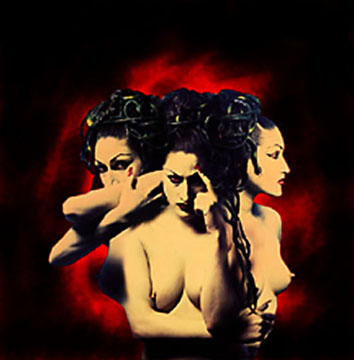
- The Erinnyes (in English, the Furies) were some seriously fearsome creatures. They were conceived when Uranus' spilled blood hit Gaia's body, and were therefore older than any of the Olympian Gods. 'These Erinnyes are crones with snakes for hair, dogs' heads, coal-black bodies, bats' wings, and bloodshot eyes. In their hands they carry brass-studded scourges and their victims die in torment.' It isn't a great idea to mention their names in conversation, so instead you should call them the Eumenides, or the Kindly Ones. There are three:
- Tisiphone, the Avenger
- Megara, the Jealous
- Alecto, the Unresting
- Eris
- Eris was the constant companion of Ares (the God of War). Eris was the Spirit of Discord as well as the Goddess of Strife. She was Night's daughter and the mother of Battle, Slaughter, Dispute, Lawlessness - I think you get the point. She is most known for throwing the Golden Apple of Discord, which, by the way, began the Trojan War through Aphrodite. Eris was sometimes said to be the twin of Ares.
- Ersa
- Ersa was a daughter of Eos, the Dawn, and Zeus. She was the Goddess of Dew. Her so-called sisters were Pandia and Nemea, who are really her cousins (their mother was Selene, a sister of Eos. I don't really know that much about her though. I'm open to information.n
- Eucleia
- Described by Mr. Bell as an 'invented divinity' she was worshipped as the personification of glory in battle in a sanctuary in Athens (after their victory over the Spartans at Marathon). I think she's kind of bizarre given that she was pretty human and lived a pretty standard life and died a virgin. But she was certainly worshipped, as I said before, and even received sacrifices before people got hitched. Eucleia was also a surname of Artemis meaning, if you haven't figured it out yet, something along the lines of good glory.
- Eumenides
- See the Erinnyes.
- Eunomia
- Her name meant Good Order. She was one of the Horae, so you will have to check there to find out more.
- Eunostos
- A Goddess of Flour Mills. They used to put little images of her up to stand guard in the mills. From what, I'm not sure.(1)
- Eurynome
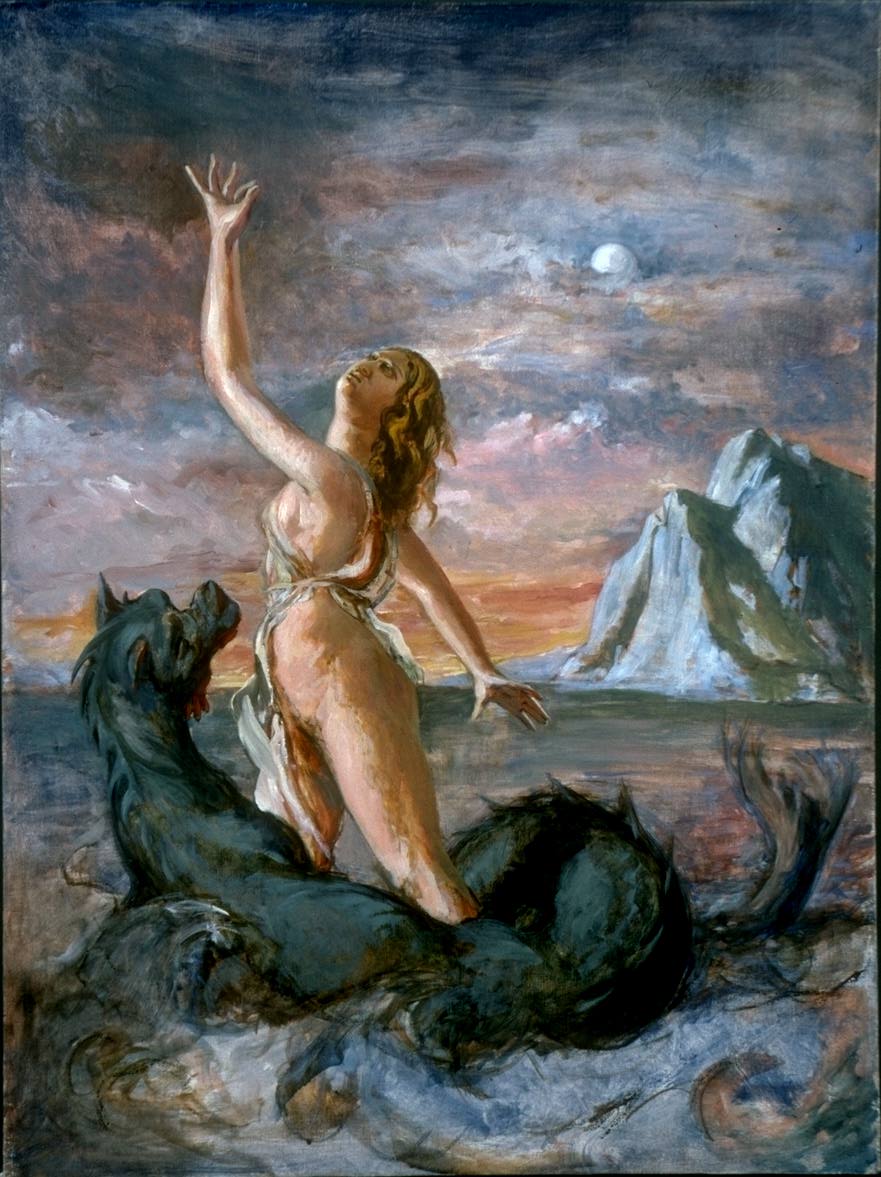
- In Pelasgian myth, Eurynome was the Goddess of All Things, born from Chaos. To read this story, check it out in the Myth Pages. Eurynome's consort is Ophion in both Pelasgian and Classical mythology, but in Classical mythology, the Goddess is the daughter of Oceanus. Things actually progressed naturally. In the Titan cult (after Pelasgian, before Classical), in the beginning, Eurynome and Ophion ruled everything together from Mt. Olympus, but were supplanted by Cronus and Rhea. When the Hellenes came, Eurynome was merely an Oceanid. That's an overview of her. If you are interested in more, just write me and ask!
- Euryphaessa
- The Titaness mother of Helios (the Sun God).
- Eutychia
- The Greek personification and Goddess of Happiness. In Roman mythology her equivalent was Felicitas.n
A quick note: We transliterate the 'phi' of ancient greek to 'ph,' not 'f' - so the only ones you'll find with 'f' are translations.
 The Fates
The Fates- The Fates, also called the Fates or the Parcae, determined when life begins, when it ends, and what happens in between. They were made up of three women:
- Clotho, who appeared as a maiden and spun the thread of life. Her name meant The Spinner
- Lachesis, who appeared as a matron and measured the thread of life. She was the Caster of lots
- Atropos, who cut the thread of life, and appeared as a crone. Her name meant, Unbending Though the smallest of the three, she is the most terrible.
- Furies
- See the Erinnyes.
 *Gaia*
*Gaia*- Gaia is Mother Earth. She has her own page, of course. She is from whom everything comes, but she is not quite a divinity, because she is Earth. She bore the Titans as well as monsters like the hundred armed men, and some of the Cyclopes - others were sons of Poseidon. She was the daughter of Chaos, and the mother of all creatures (according to some). She was the first and the last, and wanted all of her children, no matter what. She was primarily spoken of as a Mother of other Gods, rather than having her own myths. Read more about Gaia.
- Galene
- Galene, which I think is a gorgeous sounding name, was a personification of a calm sea. She was a Nereid, but that did not stop her from being a goddess, too.
- Gamelia
- Hera as the Goddess of Marriage. Gamelia is also the lunar month more or less associated with January, during which the festival Theogamia celebrating Hera's marriage to Zeus takes place.
- Ganymeda
- She was the original cupbearer to the Gods in Greek Mythology. But as time went on her person was split into two: Ganymede, who kept her duties as cupbearer; and Hebe.
- Genetyllides
- An entire GROUP of goddesses (there names seem irrelevant) who dealt with genesis. That is to say, babies. They chilled with Aphrodite. Genetyllis was the surname meaning Protectress of Birth that was assigned to both Aphrodite and Artemis. Women liked to sacrifice dogs to Artemis when they called her that.
- Geras
- She was the personification of Old Age, and one of the icky things that flew out of the jar at Pandora.
- The Graces
- See above, they're listed as the Charites.
It's worth mentioning, I think, that there is no letter 'H' in ancient Greek. Instead they have this little apostrophe looking mark that means aspiration. - The Graiai
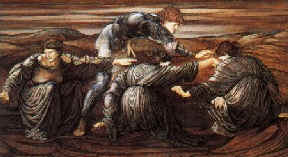
- The Graiai, or the the three Gray Sisters, were beautiful. They were described as 'fair-faced and swan-like' but they had gray hair from the day they were born and they shared one eye and one tooth, but they lost even that when Perseus stole their eye and later threw it in a lake. Despite being so easily taken advantage of, they were very wise. Their names were:
- Deino or Dread (or Terrible)
- Enyo or Horror (or War-like)
- Pemphredo or Alarm (or Wasp)
- Halia
- Halia was the personification of the saltiness of the Sea.
- Halsodyne
- Halsodyne is particularly Homerian and is a name used for both Amphitrite and Thetis. Seems to me it's all about being nourished by the sea.n
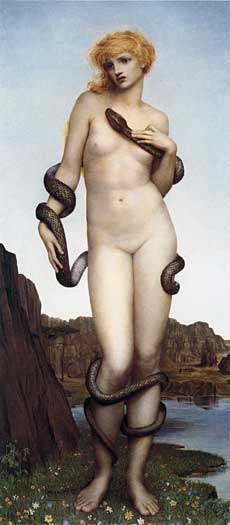
- Harmonia
- Everyone knows Harmonia, but very few know much about her. She was the daughter of Aphrodite and Ares (unless you believe the guys who say Zeus and Electra were her parents, of course), a love child if you will. Perhaps it was for that reason that she was the Goddess of Harmony and Concord, big surprise with a name like Harmonia, huh? Anyway, she was married to Cadmus (you definitely should know Cadmus, look for the story pages coming soon), and received a VERY infamous necklace as a gift (it caused the downfall of many a happy home and hero) from Aphrodite. She was the mother of Semele and Ino. Her daughters had tragic lives as well, you can read about them in the Humans section.n
 Hebe
Hebe- Hebe was the Goddess of Youth as well as the Cupbearer to the Gods, her mother was Hera and her father, Zeus. According to one story, she resigned as cupbearer to the gods upon her marriage to the hero Heracles, who had just been deified. That statue on the right is Hebe, but there is another bust of her at the bottom of the page. She was occasionally called Ganymeda or even Dia and people seemed interested in her tendency/power to make old people young again. Here's the thing about Hebe: she kinda bores me. No dark side to speak of, just a typical young girl goddess who did some time serving and did some time playing until she got married off to Heracles.
- Hecate
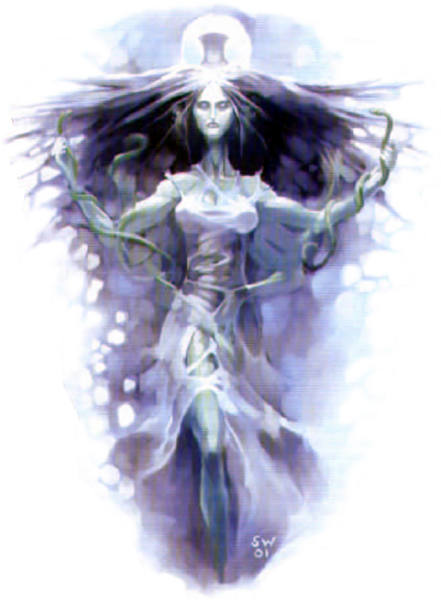
- Hecate is the Third and final one of the Triple Goddess. She is the Goddess of the New Moon. She was also the Goddess of the Crossroads and the Witch Goddess. She was Thracian in origin, and she dwelt in the Underworld with Hades and Persephone. She was the daughter of the Titans Perses and Asteria(daughter of Phoebe and Coeus), both were symbols of shining light. Later she was said to be of Zeus and Hera. There were a couple other people thrown in there, too, cuz everyone had a theory but no one agreed. She was the Dark Link between the Underworld and Earth. Her children were Medea, Apsyrtus (a ghost) (but more often they were said to have other moms). Of course, this all sounds well and good, but it doesn't get to the meat of her. Hecate was super. She was very respected on Olympus and recognized by everyone as having a lot of power. She tended towards beneficence (helping the gods against the giants, helping Galinthias after she got turned into a cat by Hera, helping out when Demeter was looking for Persephone), but people were pretty afraid of that power (which definitely included wealth, victory and wisdom, not to mention sailing and hunting) and the fact that she could choose to withhold her 'luck'. So much coolness! Forget about her being the queen of witches and a boogieman for kids who liked to sneak out, she was everything that fits those of us enchanted by the idea of a fierce, if underground, women's power. Scary, yes, but they used to set up statues of her to keep away baddies, too. And the sacrifices of food to her were left at the crossroads at the end of the month where they were eaten by the poor. See? So perfect!
- Hedone
- Really more the Greek version of the Latin 'Voluptas', Hedone doesn't so much show up in strictly Greek mythology. She is, however, the daughter of Psyche and Eros, and since I include that excellent story here, I ought to include Hedone as well.
- Hegemone
- She was a Goddess of Plants and she was in charge of making sure they bloomed and bore fruit as they were meant to. Her name means 'mastery'.
- Heimarmene
- Fate. Yes, yes, I know you just read up there about the Fates and I didn't say a thing about any darn Heimarmene, but Heimarmene wasn't quite the same as Moira. Fate, yes, but a very abstract sort of way. Maybe you should think about it as the personification of inevitability without understanding that relating to any particular life. Tyche and Ananke were described with the word version of this goddess's name.
- Helia
- She was a Goddess of the Sun, probably because she was a daughter of Helios. I know nothing else of her.
 Hemera
Hemera- Hemera was the Goddess of Day, or rather she was its personification. She was a daughter of Nyx (see below) and Erebus. She and her mother shared a house (some say it was Tartarus), but they never saw each other in it. Hemera left it each morning, and returned only as her mother (the Night) left. So sad. Oh well! She was also the mother of Thalassa, the Sea with her brother, Aether (the Upper Air, or Light). I really like her.
 *Hera*
*Hera*- Hera is most well known for being the wife of Zeus and the Queen of the Gods. Surprise, surprise! She has her own page. She was also the youngest daughter of Rhea and Cronus. Her bird is the peacock, and in almost every myth she is portrayed as being maliciously jealous. But it must also be remembered that she was the Protector of Marriage. It is believed by some scholars that she earned her bad reputation by being combined with a similar Phoenecian goddess. Read more about Hera.
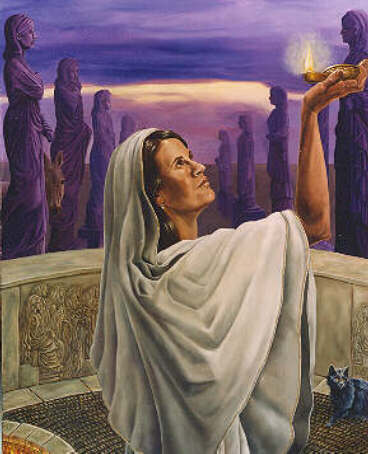 *Hestia*
*Hestia*- Hestia was the eldest of the 12 Olympian Gods and the eldest daughter of Rhea & Cronus. Guess what? She has her own page. When she began her role as a Goddess, she had a throne of her own in Olympus, but when Dionysus grew into Godhood, she willingly gave up her throne to him, choosing the hearth as an alternative. She is the Goddess of Hearth and Home she is also one of the Three Virgin Goddesses. Her symbol was kept in every house, and whenever a child was born the parents had to carry the child around the symbol before he or she could be accepted in the family. Read more about Hestia.
- Hesychia
- The personification of tranquility and the daughter of Dike, she was described by Pindar as the Goddess of Friendly Intent who makes cities greatn
- Hilaeira
- She was a Goddess of Brightness, though that could also simply be a common epithet for goddesses.
- Himalia
- She was a goddess invoked to bless the harvest. Thanks P J Criss.
 The Horae
The Horae- They were the goddesses orderly things like Seasons, and because of their orderly aspect eventually became goddesses of justice. They measured out the weather as it seemed appropriate and guarded Olympus from any overambitious mortals. They had a few cameos in the Big Myths: the Hora of Spring went with Persephone when she went down with Hades every year, and some of the Horae helped dress Aphrodite as she emerged from the ocean. They got different names (and numbers) from different authors, but I like Hesiod's breakdown:
- Eunomia, Good Custom
- Dike, Justice
- Eirene, Peace
- Horme
- The personification of energetic activity. Named by Pausanias (and, of course, Mr. Robert Bell).
- Hosia
- Hosia is a word placed before the names of Goddesses. It means something like 'holy' and 'praise' and other things along the same lines.n
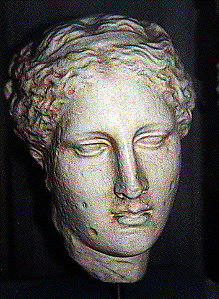
- Hygeia
- She was the daughter of Aesculapius, you know that dude who managed to raise people from the dead, and got struck down for it. She was the Goddess of Healing and she focuses on the healing power of cleanliness. She introduced the idea of washing patients with soap and water. She had lots of hospital shrines.n
- Iambe
- I'm not sure that she counts as a goddess. She was the first priestess of Demeter, the daughter of Echo and Pan. She was the first to find the lamenting goddess after Persephone's rape and abduction, and she managed to cheer her up. Iambe was full of life and friendly nature.
- Iaso
- Iaso was a Goddess of Healing and the daughter of Asclepius. He had lots of children. She was a sister of Hygia (see above).
- Ilythia
- See Eileithyia.n
- Invidia
- A daughter of Pallas and Styx, Invidia was another personification of envy.n

- Iris
- Iris is the Messenger Goddess.daughter of the Titan Thaumas and Electra. Although she was a sister of the winged monsters, the Harpies, Iris was represented as a beautiful maiden, with wings and robes of bright colors and a halo of light on her head, trailing across the sky with the rainbow she traveled on in her wake. She was also called the Goddess of the Rainbow.
- Isis
- Ooooh. So awesome. And yet, not Greek. Wait, what? I won't even put Diana on this site and I'm dropping Egyptian names? That's right, folks, because, unlike any of those Romans, Isis was actually worshipped in Ancient Greece. She makes a few cameos in the story of Iphis and Ianthe.There's no Greek letter 'J,' but sometimes the iota ('i') in combination with other vowels can make that sound. Like for Jocasta.Another quick note: the 'kappa' of ancient greek makes a hard 'k' sound, but was often Latinized to a 'c' which is how I spell it a lot. But not all the time. If they're not down here, check above and vice versa.
- Kakia
- Kakia was a seductress. She was a Goddess of Vice, and she attempted to seduce Heracles with promises of wealth and ease. Obviously, he didn't give in.
- Kale
- She was, according to some random dead bishop (!) named Eustathius who was writing about the Odyssey, one of the Charites (I don't list her because no one else seems to come up with her name). But this guy told a cool story, so why not keep it for posterity's sake? Aphrodite and the Charites were all having moments of extremely girly girl insecurity and arguing about who was the hottest of the hotties. This super wise dude named Teiresias (who really deserves to be on this site) was brought in to make the decision. Now, he'd already had some extensive experience (that involved him getting turned into a chick, check it out)with the fickle nature of the deities, but it's not like you can just say no thanks ... So he said Kale. Interesting choice, since any good self-preservation instincts would say pick the one with the most power, but maybe he'd heard about what Aphrodite gives as a reward (check it out) and didn't want Thebes going the way of Troy. Anyway, Aphrodite turned him into an old woman, but Kale gave him nice hair and a vacation to Crete. I'm with Mr. Bell (from whom I got this info since I'm not actually intimately familiar with the works of 12th century bishops) in that Kale's reward doesn't quite make up for Aphrodite's pissed off punishment, but I guess it's better than the destruction of one's country. Ahh ... the incredible destructive power of sexual women. Take note, dear reader, the root of this negativity is no coincidence!
- The Keres
- The Keres are also called the Dogs of Hades. They are associated with the Harpies and the Erinyes, and they are terrifying creatures. They are sharp clawed creatures who dress in red and drink the blood of their victims. They carry out the Fates' commands, insofar as they are in many ways the personification of the inevitability of death, and are often seen hovering around battle fields. They were daughters of Nyx, just like the Fates, and it can be a little unclear where their work ended and the work of the Erinnyes (see above) began.
- Klotes
- A Goddess of Spinning.
- Kolias
- A Goddess of Foothills.
- Komodia
- A Goddess of Happiness and Amusement. More like the personification of it.
- Kore
- An epithet of Persephone. Kore means the Maiden or Daughter.
- Krateis
- Her name means 'Mighty' and she was the mother of the monster Scylla by Phorcys. She was more commonly called Ceto, but sometimes she was called Hecate.
- Kypris
- An epithet of Aphrodite, referring to her rising out of the sea from Cyprus. The whole Aphrodite cult CAME from Cyprus to Greece. She was HUGE there.n
- Lactura
- A Goddess of Corn.
- Lampetia
- Lampetia and her sister Phathusa were daughters of Helios. They were shepherdesses for him, and guarded his sacred cattle. Well, they did until Odysseus and his men came along and stole them. But then, they all died except Odysseus, so I'd say all's fair.
- Leto
- For someone in so many myths you'd think there'd be more about her! She was the daughter of the Titans Phoebe and Coeus, that makes her a sister of Asteria (the mother of Hecate - see above). She was the mother of the twins Artemis and Apollo. She was a Moon Goddess (not a big surprise, considering her parents and sibs. You definitely should read her story on the new stories page.
- Leucothea
- The woman Ino married a married man, Athamas. She tried to make Athamas sacrifice his son Phrixes (it didn't happen, but that was how Helle, Phrixes' sister ended up dying). Anyway, Hera killed Ino, but Zeus made Ino into the Sea Goddess, Leucothea, or White Goddess, because she had raised Dionysus. There is another Leucothea too. But she was turned into an incense plant after her father buried her alive for being Helios' lover. Clytia, that nasty nymph, betrayed her.n
- Lina
- A Goddess of Weaving who used flax.
- The Litai
- The Litai were the sisters of Ate. As you'll recall, Ate was evil. The goddess of temptation and all those yucky things. The Litai, who happened to be the personification of Prayers, followed Ate around and cleaned up after her. They tried to repair the damage she did to mortals.
- Lyssa
- A Goddess of the Underworld.
- Maera
- There were actually two Maeras. The first was the daughter of Protus. This Maera was one of the cold Artemis' companions - her bad luck, in this case. For Zeus fell in love, and decided to pursue her. Artemis was NOT about that, and killed Maera (in that god-like logic, that I will never understand). Anyway, in the other version she is just a daughter of Atlas.n

- Maia
- Maia was the oldest of the Pleiades, and she was chillin' in this cave in Arcadia when Zeus came and, skipping what happened in between, she bore Hermes (my favorite masculine God), and raised him in that cave, far away from Hera's jealous eyes. After Hermes' grows up, we don't hear much more about her.
- Malophorus
- An epithet of Persephone's as a Goddess of the Underworld. It means 'sheep-bearer', probably a reference to the sheep that fell down with her when Hades opened the ground during his rape.n
- Meiboia
- A Goddess of the Bee Cult. (Be warned, I lost my source for this one.)
- Meilichia
- A Goddess of the Underworld. (Be warned, I lost my source for this one.)
- Melobosis
- A Goddess of Beneficence. (Be warned, I lost my source for this one.)
- Melinoe
- A daughter of Zeus and Persephone. She was a Goddess of the Underworld, like her mother.
- Melissa
- Melissa is greek for 'honey bee' and she was the name of Artemis as the moon goddess and the goddess who took suffering away from mothers giving birth. There were also a bunch of priestesses and nymphs with the same name, but you'll have to check on their own pages.n
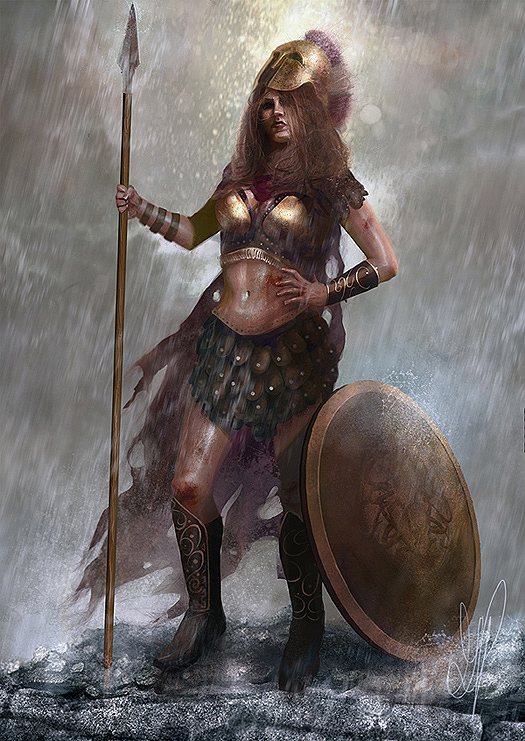
- Metis
- Metis was another Titaness. She was the Goddess of Prudence, but there is a rather unprudent story about her that tells about the birth of Athena. Metis ends up living inside Zeus' head and giving him advice from there. Her name meant Cunning and she was the personification of it as well as its Goddess. She was also the one who discovered (created) the potion that caused Cronos to vomit up the six OGs, (to all y'all who understand the joke, thank you for not being either too old or too young). Anyway, her daughter eventually burst from Zeus' head fully formed - and fully clothed in the armor her that Metis made for her - but Metis apparently had gotten comfortable in her new pad and stayed there. That painting is of Athena because I can't seem to track one of Metis down. If you are interested in learning more about Metis, I recommend you skip her myths and go straight to the heroes most famous for employing her: Odysseus and Penelope. n
- Mida
- A Goddess of Oaths. (Be warned, I lost my source for this one.)
- Mnemosyne
- Mnemosyne was a Titaness who was the Goddess of Memory. Her mother was Gaia and her father Ouranus (the Sky). She was the mother of the Muses.
- Moirai
- See the Fates.
- Molpadia
- A Goddess of Childbirth. (Be warned, I lost my source for this one.)
- The Muses
- The Muses were nine daughters of Zeus and Mnemosyne. They played and sang all of the time and entertained the Gods and Goddesses on Mount Olympus. They also inspired creativity in everyone. The Muses were:

- Erato, the Muse of Lyrics
- Euterpe, the Muse of Music
- Thalia, the Muse of Comedy
- Melpomene, the Muse of Tragedy
- Terpsichore, the Muse of Dance and Choral Song
- Urania, the Muse of Astronomy
- Clio, the Muse of Historical and Heroic Poetry, her name meant 'Proclaimer'
- Polyhymnia, the Muse of Hymns
- Calliope, the Muse of Epics
- Neaera
- Neaera means the New Moon. She was a couple of different people. One was a nymph mother of Lampetia and Phathusa by Helios. Another was the mother of Evadne. And another was the mother of Aegle by Zeus.n
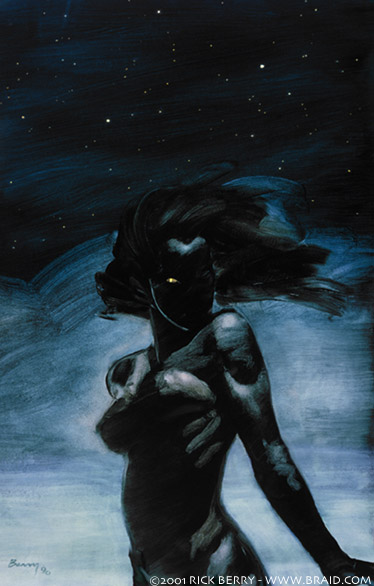
- Nemea
- This chica is the sister of Pandia, and the daughter of Selene and Zeus. She suckled the Nemean Lion (this scary monster type thing).
- Nemesis
- Nemesis she was the right hand of Zeus. She was the Goddess of Righteous Anger and it was she who saw to it that all good and evil were justly paid. She was also without a direct personality. She is also called Adrasteia, which means the Inevitable Parents. She was either another daughter of Oceanus, or a daughter of Nyx and Erebus (making her a sister to Sleep and Death). I named my lacrosse stick after her. The painting on the right is by Rick Berry.n
 Nike
Nike- Nike was similar to Eris because she was the constant companion to Athena. Nike was the Goddess of Victory. She was the daughter of the Titan Pallas and the River/Nymph Styx. She does not possess a distinct personality in any myths I've seen. Further, Nike was sort of an epithet of Athena. But Nike, as the personification of Victory was also worshipped as her own Goddess, and usually showed with wings, except in Athens where she was called 'Apteros' ('wingless'), with the idea that she would never leave Athens.n

- Nyx
- Nyx was a daughter of Chaos (and so a SISTER of Gaia, and with her brother Erebus (Darkness) she bore: Air, Hemera, Aether (Light), Moros (Destiny), Thanatos (Death), Hypnos (Sleep), Morpheus (Dreams), The Fates, The Keres, Eris, Momus (Ridicule), Oizys (Distress), Apate (Deceit), Care, and Nemesis. Her realm was in the far West beyond the land of Atlas. n
- Odyne
- She was the personification and Goddess of Pain. How pleasant.
- Oizys
- She was a daughter of Nyx and the personification of Woe.
- Ophthalmitis
- Patron Goddess of Eyesight. Now, who'd a thunk it? But she wasn't really that specific - it was really just a surname of Athena in Sparta. This guy named Lycurgus dedicated a temple to Athena when one of his eyes was struck out by Alcander (this dude who was bitter about Lycurgus' laws). But they saved the eye and rededicated the temple to Athena Ophthalmitis.
- Oreilochia
- Oreilochia was another name for Iphigenia - but wait, you are thinking, Iphigenia was HUMAN! Heh. Maybe so . . . but there's this story that say that Artemis didn't take her as a sacrifice, but spirited her away to the island of Leauce. There, these traditions say, she became immortal AND got eternal youth (becoming rather goddess-like, wouldn't you say?) and became Achilles' wife under the new name of Oreilochia.
- Ossa
- The Goddess of Rumor, more like the personification of it. Her equivalent in Roman Mythology was Fama. She was also called a messenger of Zeus, and she had an altar in Athens. She was called the daughter of Elpis (or Hope).n

- Otrera
- This chick was really mysterious. She is believed to be the mother of the Amazons by many, and their mother by Ares . . . but, it seems that she was probably Ares' daughter, as well - not to mention that no one has any guess as to her mother was. She was a real war-chick - not like Harmonia at all.n
- Pallas
- Pallas was an epithet of Athena, meaning Maiden or youth. The name has a story though. There was once another named Pallas, accepted by most as the girl-companion of the young Athena. When the two were little they decided to play a game of friendly combat with sword and spear, and Athena accidentally killed her. In her grief and remorse, Athena put Pallas' name before her own. There is a more complete version of this in the Nymphs section and more again in the story of Athena's birth.
- Panaceia
- She was one of the many daughters of Epione and Aesclepius. She was sister to Hygeia, Aegle, and Iaso. Like the other members of her family, she was a Goddess of Healing. Her name, in fact, was the All Healing. She shared an altar with her sisters and Aphrodite and Athena.
- Panachaea
- She was specifically, Goddess of all the Achaians, but WHO she was is debatable. In Aegae she was Demeter, and in Patrae she was Athena.n

- Panatis
- A Goddess of Weaving.
- Pandia
- Her name meant 'All Bright' and she was the Goddess of the Brightness, especially the Sun. She may have also been the Goddess of the Full Moon, as she was the mate of Zeus in his epithet of Zeus Pandion (the Full Moon God). I got my info straight from Encyclopedia Mythica on this one. Another source says that she and her sisters were the daughters of Zeus and Selene.
- Pandrosos
- She was worshipped as a Goddess of Agriculture and was credited by some for the introduction of weaving. She was one of the Agraulides. Basically, she was one of the daughters of Cecrops and Agraulos who killed herself - yet started being worshipped in a sort of heroine cult. If you want to know the story behind her suicide, check out the story of Erichthonius in the Myth pages. I'm not actually sure if it's there yet. It's a cool story, though!
- Paregoros
- This daughter of Tethys and Oceanus was a Goddess of Persuasion and Consolation. Despite her parentage, she was NOT a water deity.
- Parthenos
- Parthenos, as in Parthenon, was an epithet of Athena. It means Virgin. The Parthenon is a temple to Athena in Athens, Greece (what a shocker!).
- Pasiphae
- Not to be confused with the bull-lovin' Queen o' Crete (here), this was a daughter of Atlas and she was an oracular Goddess. There are different opinions of how her life went, including that she was just a godly version of Cassandra, and that she was Daphne. But a lot of people believed in her, and people would sleep in her temple to dream of the future.n
- Peitho
- Peitho was the personification of Persuasion. She was an attendent of the Aphrodite, as well as one of the Gamelii (a Protectress of Marriage) the attendants of Hera.
- Penia
- I don't care how old I get, this name will always make me giggle. Penia. Hee hee. Yeah, so anyway, Penia was the personification and Goddess of Poverty. She was worshipped among the poor. Legend has it that after a feast on Olympus she married Porus, the personification of 'Expediency.' Some say that she and Porus gave birth to Eros. Heh. Penia.
 Persephone
Persephone- Persephone was special, which is part of why she has her own page. She was the daughter of Demeter, the Maiden of Spring. Wherever she walked flowers grew. Unfortunately, one day Hades, the God of the Underworld, abducted her, raped her, and made her Queen of the Underworld. There was no escaping the misery of her new realm either because she had eaten seeds from a pomegranate that grew there. So she was miserable for the half of her life she spent with him. However, because of her mother's advocacy, she was allowed to spend sometime in the world with her. This obvious connection to the seasons is not coincidental, and formed one of the most important Mysteries of ancient Greece. Read more about Persephone.
- Pheme
- Pheme was the Goddess of Popular Rumour. She had a temple in Athens. Pheme was always prying. She announced whatever she heard, first to only a few, then louder until everyone had known. Pheme was represented as a winged, gentle figure holding a trumpet.
- Phemonoe
- She invented hexameter verse. She was the Goddess of Poetry and the daughter of Apollo and his first priestess at Delphi.
- Philia
- She was mostly associated with Peitho, but she also had a temple to her in Athens. She was the personification of Friendship. She wasn't a Muse despite a related topic.
- Philote
- Philote was the Greek personification of Affection. She was one of the MANY daughters of Nyx. Wow, I never knew about her before the Encyclopedia Mythica. What a cool Goddess.
- Philyra
- Philyra was a Thessalian Goddess. She was a shape-shifter, and the Goddess of Beauty, Perfume, Healing and Writing. She was also given credit for the invention of paper. She was the mother of Cheiron (the wise and oh-so-cool King of the Centaurs) by Cronos (the father of Zeus). If you're wondering how Cheiron ended up as in centaur form despite his different heritage, it is because his mom and Cronos did the deed in horsey form. Philyra was the daughter of Oceanus (but probably not Tethys).n
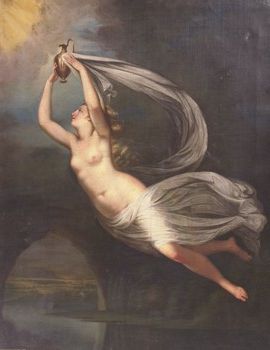
- Phoebe
- Phoebe was a Titan, one of the original (that is, pre-classical) 14. She and Atlas were given dominion over the Moon, whose planetary power is that of Enchantment, and the second day of the week was their's. So, Phoebe is another Moon Goddess, her name means Bright Moon. She was the mother of Leto and Asteria through her brother Coeus(Intelligence). There was another Phoebe, a human priestess, who figures briefly in the story of Castor and Pollux. Anyway, it's Phoebe who was the grandmother of Artemis and Apollo, and her name became surnames for both twins.
- Physis
- The personification of Nature.
- Phytia
- It means Creator, and it was the surname of Leto when saved a girl baby's life by changing its sex to male when the child's father would have otherwise killed the baby.
- Pleiades
- Check out the Pleiades on the Nymphs Page.n
- Poene
- The Goddess of Retaliation. Interesting. . . not retribution, like most of them, but retaliation. She was in the train of Dike and was once sent in the form of a monster punish the people of Argos for killing Psamathe (where she apparently got killed!).n

- Polias
- Polias is an epithet of Athena as the protector of the Acropolis and Athens. The word polis means city in Greek.
- Potnia
- Potnia is just the Greek word for 'mistress' and is put in front of a lot of things, especially if you're talking about Mothers, but it was also used (I imagine, but am not sure) in conjunction with various goddesses.n
- Praxidice
- A Goddess of Oaths.
- Protogenia
- She was the Goddess of Success in Business. She was really an earth goddess, but managed to become associated with the city-life. As society changes, so does theology.
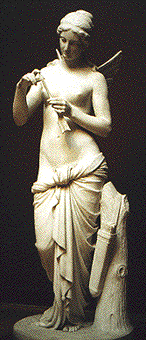 Psyche
Psyche- There's not a lot that I don't know about this chick. She was the Goddess of the Soul. She was the wife of Eros (God of Love, son of Aphrodite) and their myth is about how Love and the Soul came together. It is a beautiful story, and now it is HERE! In the Myth Pages. A quick once over is she got abandoned on a mountain, an invisible dude picked her up and took her home with him. She went all Pandora and figured out it was Eros (read the story to learn how she figured it out), and, after many trials, she lived happily ever after. Or did she?
- Ptocheia
- The personification of Begging and the sister of Penia.n
- Pyrrha
- Pyrrha was a later Titani, a daughter of Epimetheus. She married Deucalion, a son of Prometheus. Prometheus warned Deucalion that Zeus was pissed, and they made an ark and survived Zeus' flood. As they were the only ones to survive, they became the first of the new human race. For more on the story, check out the detail version in the Myth Pages. The name Pyrrha means Fiery Red.n
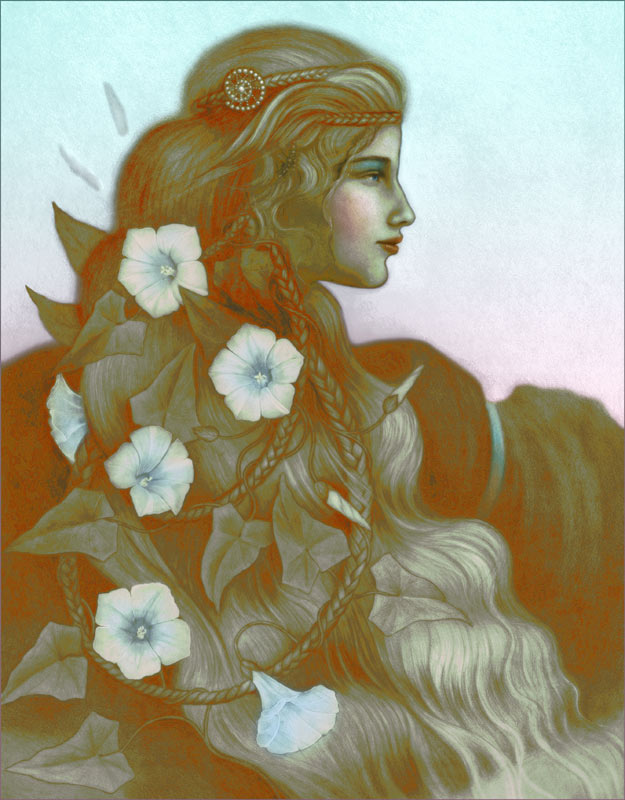
- Rhea
- Rhea was far more powerful in the days before classical (ie, patriarchal) mythology came around. In Orphic she was the 'inescapable mother Rhea' who sat outside the house of Nyx beating a bronze drum and making sure all humans were paying attention the oracle of the goddess. In Pelasgian Myth (soon before classical myth took hold) she was one of the 14 original Titans, paired, of course, with Cronus. They held dominion over the last day of the week, and the planet Saturn. In pre-Hellenic Greece the planetary power of Saturn was peace. Rhea loses a lot of her importance in the Olympian creation myth, but still holds some power. She causes her husband Cronus to stop eating his children, saves Zeus and (indirectly) brings the Olympian Gods into power. That's a great story, check it out here. She is raped by her son Zeus when she tells him he may not marry, despite her change to a snake. She also had a big role in her grandson Dionysus' life. She is also often called Cybele.
- Salmaone
- I don't really know anything about her, but would like to, so if you can find me a source, I'd love to see it!n
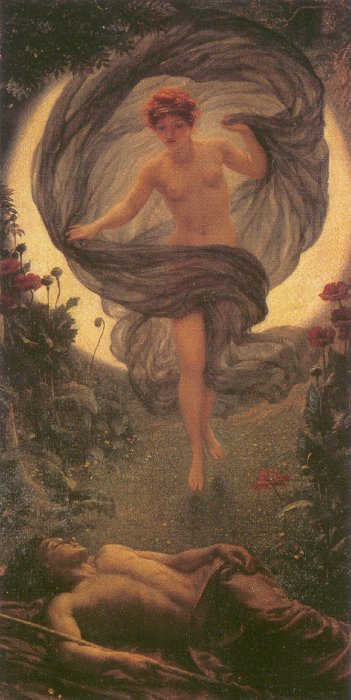
- Selene
- Selene was the Goddess of the Moon. She was the daughter of the two Titans Hyperion and Theia (see below). She married mortal Endymion (a shepherd who she caused to sleep forever so that he wouldn't get old and gross) and had 50 daughters (I don't know what happened to them). If you want to read the longer version of the story, read it here. She is a part of the Triple Goddess (there will be a section on the Myth pages explaining the phenomenon of Triple Goddesses, so keep looking). She rode across heaven in a chariot with milk-white horses. In Roman (puh-tooey) mythology she was called Luna.
- Sophrosyne
- A Goddess of Temperance and Moderation. This concept seems to be pretty important to the Greeks, although I can no longer find my source for this goddess, and she was clearly not that crucial a deity.
- Soteira
- Just the Greek word for Saviour, and was applied to different goddesses in different contexts.
- Tabliope
- A Goddess of Gambling. I didn't make this one up, but I've lost the source, so I wouldn't use it in any job applications without checking your evidence. Or something.
- Techne
- Techne is Greek for skill, and thus would, as a goddess, personify that skill, probably particularly useful for artisans.
- Telete
- The daughter of Nicaea and Dionysus. Her daddy drove her mama to suicide, and Telete became the personification of Consecration.
- Tethys
- Tethys was a Titan, both original and classical. She and Oceanus ruled the planet Venus and the sixth day. From their planet they received the power of love. Some say that the Gods and everything populating Earth was born from Oceanus' stream, and that Tethys was their mother. To Homer, Tethys was very like what Eurynome was to the Pelasgians. In more classical mythology the Titaness Tethys was the wife of her brother Oceanus and by him the mother of the 3000 Oceanids and of all the river gods. She was a Goddess of the Ocean, but eventually ceded to Doris, who ceded to Amphitrite. Tethys was the Godmother of Rhea (see above), and raised her during the civil war between the Gods and the Titans. Her name means Disposer and is very similar, in root, to Thetis.n
- Thalassa
- She was the personification of the Mediterranean Sea, and the daughter of Hemera (Day) and Aether (the Upper Air) - two of the first beings created. Many sea deities seem very social in their chaos, always creating new and changing life, but Thalassa was much more isolated and more referred to in metaphor; she was a goddess of lonely shores. She didn't totally escape the life-giving aspect of her sea-nature, she was the mother of all fish by Poseidon, but even there, she is a much more primitive and inhuman power than others we are accustomed to seeing (Amphitrite, Thetis, etc).
- Thaleia
- Thaleia was apparently (in addition to a different Thaleia being one of the Charites) the daughter of Hephaestus and some unknown mother. She had a fling with Zeus, and, no surprise, got pregnant - but she knew about Hera's vengeance and asked Zeus to let the Earth swallow her. He granted her request, and her children, the twin Palici, were the protectors of solemn oaths - and in the old days, some people say they were offered human sacrifices. The mama stayed in the Earth, I guess - they don't mention what happened to her.
- Theia
- One of the original seven Titanesses, Theia was the mate of Hyperion. They were connected in the 'planetary power' of the Sun and the first day of the week. The Sun's power was, surprise, Illumination. She was associated with light and the sky, she was an early Goddess of Light. She was the mother of Helios, Selene (see above), and Eos. The name Theia means Divine, and she was also referred to as 'the cow-eyed Euryphaessa'. Euryphaessa means Wide Shining.
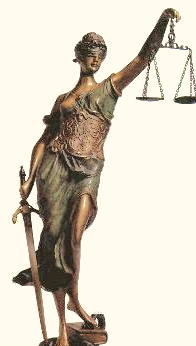 Themis
Themis- Themis was one of the origninal Titans, and shared dominion of Jupiter with Eurymedon (fifth day). Their power was that of Law and her name means Order. The Titaness Themis was the mother of the the Seasons (and some say the three Fates) with Zeus. The Goddess of Divine Justice and Law, Themis was the constant companion of the god Zeus and sat beside him on Olympus. In ancient art she is represented holding aloft a pair of scales on which she weighs the claims of opposing parties. Before and during this, however, she was also the Great Goddess who ordered the 13 month year, divided into two seasons. She was the prophet who declared that Thetis's son would be greater than his father (ever heard of Achilles?). It was Themis who appeared before Deucalion and Pyrrha (see above) and told them how to keep their race from dying out after the flood (click here for more). There was a altar dedicated to her by Pittheus in Troezen. She was very important and with Zeus plotted to create the Trojan War. That's all about her for now.
- Thetis
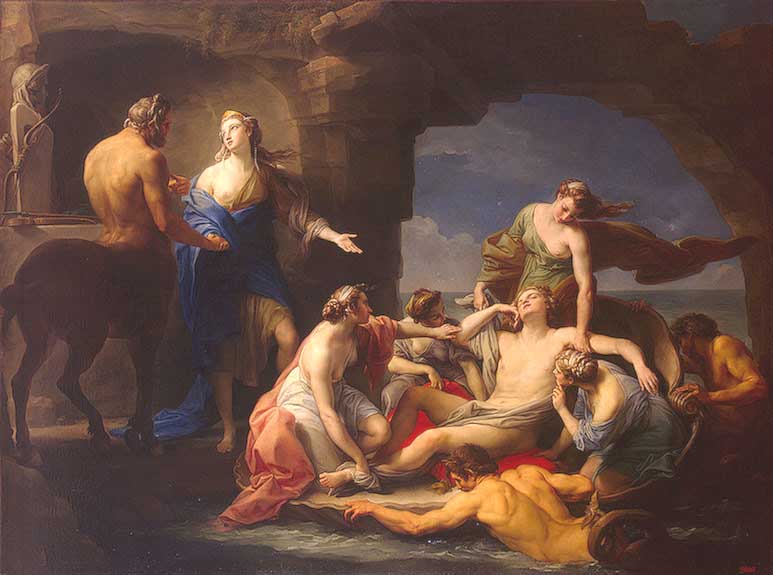 Thetis was the chief of the Nereids. She was such a hot number that Poseidon, while he was looking for a wife, courted her. Zeus too, courted her, but she rejected him for the sake of Hera, her foster-mother. Then Themis prophesied that Thetis was to bear a son stronger than its father, so Zeus decreed that she must marry a mortal. Hera, remembering Thetis' rejection of Zeus, set her up with 'the best of mortals.' Thetis married Peleus and bore Achilles. But there was more to it than that. She saved her father once; when all the other Gods got pissed and tied him up she went and got the Hundred-Handed Briareus. She also played a large part in the birth of Hephaestus. Like Tethys (see above) the name Thetis means Disposer.
Thetis was the chief of the Nereids. She was such a hot number that Poseidon, while he was looking for a wife, courted her. Zeus too, courted her, but she rejected him for the sake of Hera, her foster-mother. Then Themis prophesied that Thetis was to bear a son stronger than its father, so Zeus decreed that she must marry a mortal. Hera, remembering Thetis' rejection of Zeus, set her up with 'the best of mortals.' Thetis married Peleus and bore Achilles. But there was more to it than that. She saved her father once; when all the other Gods got pissed and tied him up she went and got the Hundred-Handed Briareus. She also played a large part in the birth of Hephaestus. Like Tethys (see above) the name Thetis means Disposer.- Thoosa
- Thoosa was the personification of swiftness.
- Thyone
- Remember Semele, the mother of Dionysus? Well, after she got all crispy and died, Dionysus went down and got her back from Hades realm. What a nice son taking his mom up to Olympus and making her immortal ... anyway, upon becoming immortal she received a new name, and Thyone was it!n
- The Titanides
- The Titanides were the six daughters of Gaia and Uranus, the sisters to the Titans. There was one assigned to each of the seven planetary powers and to each day of the week, they shared each position with a brother. In order of their day of the week they were: Theia and the Sun (illumination), Phoebe and the Moon (enchantment), Dione and Mars (growth), Metis and Mercury (wisdom), Themis (see above) and Jupiter (justice), Tethys (see above) and Venus (love), and Rhea (see above) and Jupiter (peace). They existed before the Olympian Gods (like Zeus, Hera, Athena, etc.), and were co-opted into that culture as mothers of minor deities with their Titan brothers and husbands. The breakdown of power is as given by Robert Graves, who is not necessarily worth believing n
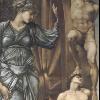
- Tyche
- Tyche was the Goddess of Fortune. It is widely accepted that she was the daughter of Zeus, though some reports give her to be the daughter of Oceanus and Tethys (see above). It was in her temple that the first dice was reportedly made. If however, she ends up bestowing wealth upon someone, and they do not sacrifice appropriately to the Gods, then Nemesis steps in and takes care of business. Tyche was very widely worshipped, despite her hard-to-guess nature.n
(null)
A | B | C | D | E | F | G | H | I | J | K | L | M | N | O | P | Q | R | S | T | U | V | W | X | Y | Z
Home | Blog | The Famous Ones | Goddesses | Humans | Nymphs | Monstresses | The Myth Pages | Amazons | Men | Gallery | Dreambook | Search | References
Contact me at ailiathena@yahoo.com